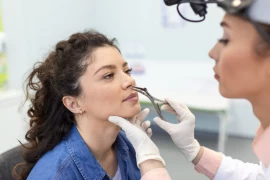
Conditions Requiring Ear Aesthetics
- Conditions Requiring Ear Aesthetics
- Ear Aesthetic Surgery Risk Ratio
- Things to Consider Before Ear Aesthetics
- How Long Does Ear Aesthetic Surgery Take
- Healing Processes After Ear Aesthetic Surgery
Ear aesthetics is a surgical intervention for the correction of congenital or acquired deformities of the ears.
Among the situations that require it, the most common are:
- Congenital ears that are too big or too small
- Congenital deformities of the ears, such as being too flat or raised
- Deformities of the ears as a result of subsequent ear trauma
- Situations where the ears are in the wrong position
Ear aesthetic surgery can be performed to correct these conditions. However, the age, health status and expectations of the person should be taken into consideration before the decision for surgical intervention is made.
Ear Aesthetic Surgery Risk Ratio
Ear aesthetic surgery is generally a safe and successful surgical procedure. However, like any surgical procedure, there are some risks in this surgery.
These risks include:
Bleeding: There may be bleeding during or after the surgery. This is rare and usually easily controlled.
Infection: There is a possibility of infection after surgery. This is rare and can usually be prevented with antibiotic treatment.
Deformity: After the surgery, the shape of the ears may not be as desired and correction surgery may be required.
Skin sensitivity: After surgery, your skin may be sensitive and cracks may occur.
Nerve damage: There is a chance that nerve damage can occur, but this is rare.
Loss of sensation: There is a possibility of loss of sensation during surgery, but this is rare.
In order to reduce these risks, it is important that it is performed by an experienced and authorized surgeon. It is also important to carefully follow your doctor's instructions before and after surgery.

Things to Consider Before Ear Aesthetics
Ear aesthetics (otoplasty) surgery is a surgical procedure performed to correct congenital or acquired deformities of the ears. Beforehand, a detailed consultation between the patient and the doctor is required. During this consultation, information is given about the patient's expectations, the condition of the area where the surgery will be performed, potential risks and results. In addition, information about the patient's health status is obtained and all necessary examinations are performed. This information helps the doctor create the surgery plan.
How Long Does Ear Aesthetic Surgery Take
Ear aesthetic surgery usually takes between 1-2 hours and is generally considered a minor surgical intervention. However, the duration of the operation may vary depending on the degree of ear deformity and the area that needs to be corrected. For example, the operation time may be shorter in cases where only one ear needs to be corrected, while it may be longer in cases that require simultaneous correction for both ears.
In addition, the duration of the operation may vary according to the age, health status and surgical technique of the person. For example, ear aesthetic surgeries for children are usually shorter, while for adults they may be longer. In addition, while operations performed with classical surgical techniques may take longer, the duration may be shorter when endoscopic surgical techniques are used.
Healing Processes After Ear Aesthetic Surgery
- In the first few days after surgery, you may have mild pain and swelling in your ears. This is normal and can be relieved with pain medication.
- You must use a bandage for your ears after surgery. This bandage is a tool that maintains the shape of the ears and speeds up the healing process.
- During the healing process of your ears, it is necessary to avoid exposure to water such as swimming, sauna, bathing.
- Heavy exercise and physical activities should be avoided for 2-3 weeks after the surgery.
- The shape of your ears may change after surgery and therefore you should carefully follow the instructions given by your doctor.
- Until the shape of your ears is finalized after the surgery, you should cover your ears with a protective cap.
- It is important to protect yourself from the sun, as there may be color changes in your ears after the surgery.
- Cracks may occur on your skin after the surgery, so it is important to moisturize your skin.
- After the surgery, you need to have the controls programmed by your doctor, these controls are to monitor your recovery process and make the necessary interventions.
- If you are concerned about the shape of your ears after surgery, it is important to keep in touch with your doctor.





